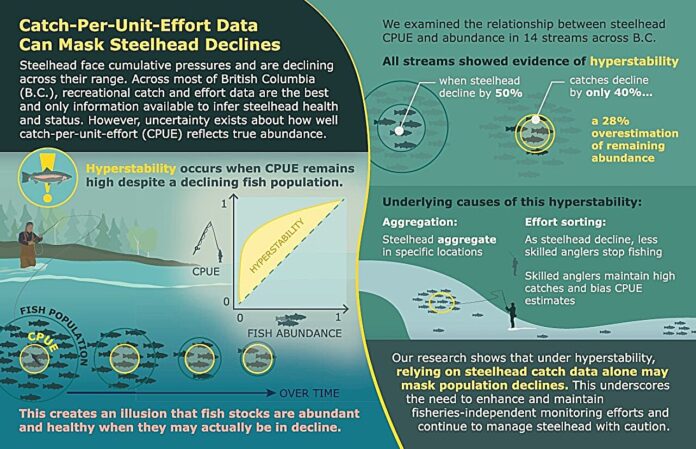An iconic fish among British Columbia anglers could be facing an even more uncertain future than previously thought, according to a new study from Simon Fraser University researchers.
Steelhead have faced growing threats over recent years, leading to conservation concerns.
B.C. is home to more than 400 steelhead-bearing streams, but very few of these are actively monitored.
Often the only available information comes from surveys of anglers regarding the number of steelhead that they catch and release. However, according to the new research, these data may not accurately reflect the health and status of steelhead.
The study, published in the journal Transactions of the American Fisheries Society, analyzed catch data from steelhead anglers in 14 streams across B.C.
Researchers found that catch rates may stay high even as steelhead populations decline, creating a dangerous illusion of plenty. This phenomenon is known as hyperstability.
“Our results suggest that individual catch rate may not be a reliable indicator of changes in steelhead populations,” says Julie Charbonneau, the study’s lead author and researcher with the Earth to Ocean Research Group at SFU.
“While they are socially and economically significant, steelhead are not monitored to the same extent as other commercially targeted species. So for many stocks, angler catch data is usually the only available form of data.”
A disconnect between catch rates and actual fish numbers can arise when skilled anglers continue to locate fish, despite population declines.
Steelhead naturally aggregate in specific areas in rivers, such as riffles or pools. While they are renowned to be difficult to catch, if skilled anglers can locate those areas they can still catch a number of fish.
This can give the impression that the population is healthy, when it may actually be in decline.
“If hyperstability is as prevalent across the province as suggested by this analysis, then the observed declines in catch rates could be associated with substantial declines in true abundance,” adds Charbonneau.
Steelhead—Oncorhynchus mykiss (anadromous Rainbow trout)—are among the most recreationally sought-after fish species in western North America and also have strong social and economic significance.
B.C. attracts some 21,000 steelhead anglers every year, generating $50 million in revenue.
Yet steelhead fisheries have been facing mounting threats over recent decades, notably from climate change and habitat degradation.
The historically famous North Thompson River steelhead population has collapsed and recreational fisheries have been closed since 2018.
A recent report from the Pacific Salmon Foundation found that several steelhead populations in B.C. are experiencing “severe declines in abundance.”
“Catching more fish does not necessarily indicate high levels of abundance,” says the study’s co-author Katrina Connors, senior director of salmon programs at the Pacific Salmon Foundation.
“Without proper monitoring, we may be unable to detect declines of steelhead populations, potentially leading to conservation concerns.”
More information:
Julie A Charbonneau et al, Hyperstability in an inland recreational fishery: Are catch-per-unit-effort data masking the magnitude of steelhead declines?, Transactions of the American Fisheries Society (2025). DOI: 10.1093/tafafs/vnaf023
Provided by
Simon Fraser University
Citation:
Study suggests data may be masking steelhead declines in British Columbia (2025, July 24)
retrieved 24 July 2025
from https://phys.org/news/2025-07-masking-steelhead-declines-british-columbia.html
This document is subject to copyright. Apart from any fair dealing for the purpose of private study or research, no
part may be reproduced without the written permission. The content is provided for information purposes only.



